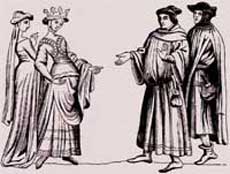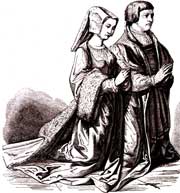Medieval Life
Was Medieval Life dull and monotonous, or shiny armors and tournaments made it a fairytale one? The answer depends on which class of Medieval society you are referring to.
In Medieval France, as early as the beginning of the Merovingian era, life among the upper classes was more luxurious and comfortable than is generally supposed. All the gold and silver furniture, all the jewels of the Gallo-Romans, had not been destroyed by the Frank Kings, who appropriated everything that flattered their pride and sensuality. This is how the material remains of the civilization of the Gauls were preserved in the royal and noble residences, the churches, and the monasteries. The private properties of the Frank kings were immense, and produced enormous revenues.

Noble Lady and a Maid of Honor
14th Century
In times of peace the Medieval nobles dedicated most of their daily life to hunting. It frequently happened that hunting occupied whole weeks, taking them far from their homes and families. When the season did not allow them to hunt, the nobles enjoyed feasting and gambling.
The custom allowed the invited guests to appear armed at the feasts, where the wine and beer were flowing freely. When followed by games of chance, the feasts often resulted either in private quarrels or in a general mêlée. As early as the Merovingian times, the kings tried to curb the excesses, and invited at their tables bishops, who blessed the assembly at the commencement of the meal. They were also reciting chapters of holy writ, or were singing hymns of the divine service, trying to occupy the minds of the guests.
Under Charlemagne's reign, Medieval life seems to have been less rough and coarse, although his subjects did not entirely give up their turbulent pleasures. After a long time of being confined in the monasteries, science and letters were given much more consideration at the Imperial Court.
From the middle of the 9th to the middle of the 12th centuries, due to endless wars, life in the Medieval castles offered little pleasure. Still, it was the epoch when chivalry started to influence the private life, considerably modifying customs, and by bringing the stronger sex to respect and defend the weaker.
Life at a Middle Ages Royal Court was more or less sumptuous, according to the Kings views on the royal household economy. Philip Augustus, Louis IX, Philip le Bel (the Fair), all tried to strictly regulate the expenses of the Court.
Due to many people displaying a life of excessive luxury, in 1294 an order of the King was issued, regulating in detail the expenses of each person according to his rank in the State, or the fortune which he could prove. The law was easily evaded. Another futile attempt to put it in practice was made in 1300, when the splendor of dress, and of equipages, had descended progressively to the bourgeois and merchants.
The great tenants or vassals of the crown each possessed splendid mansions in their fiefs. From the 15th to the 16th centuries, the provinces which now compose France were studded with castles, which were as remarkable for their interior and architecture as for the richness of their furniture.
A custom which contributed to the softening and elegance of Medieval life was that of sending into the service of the sovereign for some years all the youths of both sexes, as pages, squires, and maids of honor. No noble, of whatever wealth or power, ever thought of depriving his family of this apprenticeship and its accompanying chivalric education. Up to the end of the 12th century, the number of domestic officers attached to a castle was very limited. Under Louis IX. this household was increased, and under Philippe le Bel and his sons the Royal Court has grown considerably.

Burgess of Ghent and his wife
kneeling in church
From the 11th to the 13th centuries, a new class emerged, the bourgeoisie. Once the burghers established their status within the Medieval society, their private life started to be an imitation of that in the châteaux, and they were trying to display a luxury equal to that of the upper classes. Edicts, summary laws, coercive regulations, and penal ordinances, all the arbitrary restrictions the nobility laid upon them in trying to limit the sumptuosity of their appearance were unsuccessful. When the bourgeoisie acquired places in the council of the King, or in the administration of the provinces, many of its members distinguished themselves by firmness and wisdom; when called upon to assist in the nation defense, they gave their blood and their gold, and they proved they also possessed the high sentiments of which the nobility alone claimed the hereditary possession.
In the 13th century the women of the bourgeoisie were not permitted, without incurring a fine, to use the ornaments and clothes exclusively reserved for the nobility. This applied even to the wives and daughters of the rich merchants. During the reigns of Philip Augustus and Louis IX., although the arbitrary laws were not abolished, a heavy blow was inflicted on them by the confidence these monarchs placed in the bourgeoisie. We find the first of these kings, when on the point of starting for a crusade, choosing six burghers to be attached to the Council of Regency, to whom he specially confided his will and the royal treasure.
His grandson made a point of following his example, and Louis IX. showed the same appreciation by making the bourgeois Etienne Boileau one of his principal minister of police, and the bourgeois Jean Sarrazin his chamberlain. During the following reign, the ladies of the bourgeoisie, proud of their immense fortunes, but above all proud of the municipal powers held by their families, began to defy the law, and displayed such a luxurious life that Philippe le Bel (the Fair), who inclined more to the nobles, issued a new edict about what the bourgeois should should wear. But these regulations to the mode of living were little observed. All the successors of Philippe le Bel thought it necessary to reenact them, and, indeed, Charles VII., one century later, was obliged to censure the excess of luxury in dress by an edict which was, however, no better enforced than the rest. In spite of the laws, the Parisian burghers soon rivaled the Flemish in the brilliancy of their dress. Thus, in the second half of the 14th century, the famous Christine de Pisan relates that, having gone to visit the wife of a merchant during her confinement, she was amazed when she saw the sumptuous furniture of the apartment of this woman.
Now a few words on the Medieval countryside life. The Medieval peasants were divided in free men, villeins, and cottars. The free men were renting the land from the feudal lord, having to pay fixed dues in return, but owing no labor services. The cottars worked the lord fields, receiving in return a dwelling, and a small portion of the harvest.
By far the largest category was represented by the villeins. Although Medieval documents are mentioning them as being free, it was not so. Their land belonged to the feudal lord. They were not free to leave the domain, and they had many obligations like additional work at master's fields harvesting, and the payment of dues.
Harsh as it was, life in the Medieval villages still had its days of rest and amusement. At that period the festivals of the Church were frequent and rigidly kept, and each of them was the pretext for a holiday from manual labor.
